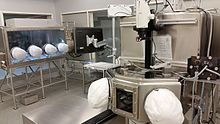Lunar Sample Laboratory Facility

Vintage (left) and contemporary (right) glove boxes as seen in 2015
|
|
| Established | 1979 |
|---|---|
|
Field of research
|
Geology |
| Address | Lyndon B. Johnson Space Center |
| Location | Houston, Texas, USA |
|
Operating agency
|
NASA |
| Website | curator |
The Lunar Sample Laboratory Facility (LSLF) is a repository and laboratory facility at NASA's Lyndon B. Johnson Space Center in Houston, Texas, opened in 1979 to house geologic samples returned from the Moon by the Apollo program missions to the lunar surface between 1969 and 1972. The facility preserves most of the 382 kilograms (842 lb) of lunar material returned over the course of Apollo program and other extraterrestrial samples, along with associated data records. It also contains laboratories for processing and studying the samples without contamination.
Planning for handling returned lunar samples began early in the Apollo program. In 1964, a proposal was made for a small (10 square meters (110 sq ft)) sample receiving laboratory equipped with remote-controlled manipulators operating in a sterile, high-vacuum chamber to prepare samples for distribution to scientists, and this proposal was subsequently expanded to include a clean room with analytical instruments for performing preliminary analyses on the samples.
A committee of the Space Science Board reviewed the idea of a lunar sample receiving laboratory and sought to address multiple concerns. One was the fear that creating a facility with too great a capacity to analyze the samples would discourage distribution of samples to outside researchers and effectively exclude them. In addition, space biologists and the United States Public Health Service expressed concern about "back contamination" of Earth by extraterrestrial microorganisms brought back via returning spacecraft, (although many of the astronauts and scientists involved in the program were skeptical that non-terrestrial microorganisms could survive lunar conditions). To address these issues, the committee in 1965 recommended a laboratory with limited analytical capacity and an ability to quarantine the returning astronauts and samples.
The result of this planning was the Lunar Receiving Laboratory (LRL) in Building 37 at the Johnson Space Center, built to process and conduct basic analysis on lunar materials and to quarantine the materials and astronauts. (The requirement that astronauts be quarantined following their missions was dropped beginning with Apollo 15.) The 8,000-square-meter (86,000 sq ft) LRL was completed in 1967 at a cost of $7.8 million. The LRL was used for study, distribution and safe storage of the samples, but although the LRL had adequate facilities to process samples for the current mission, the facility was not ideal, and it lacked facilities to process or store samples from previous missions. To address some of these concerns, NASA dropped the requirement after Apollo 12 that samples be processed in vacuum (in favor of a simpler-to-work-in nitrogen atmosphere). An additional vault and, subsequently, a new laboratory – the Sample Storage and Processing Laboratory (SSPL) – were built in Building 31 of the Johnson Space Center. All lunar samples were moved from the LRL to Building 31 after the last Apollo mission
...
Wikipedia
